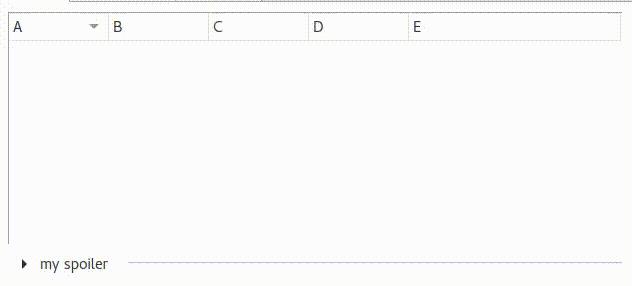I stumbled upon the same problem and solved it by implementing the collapsible widget as a QScrollArea whose maximum height is animated by a QPropertyAnimation.
But since I don’t use QDesigner, I can’t tell you if it works there.
I still have one problem: Instead of only expanding towards the bottom direction, the collapsible widget can expand towards the top and bottom. This can cause widgets located above it to shrink if they haven’t reached their minimum height, yet. But this is really a detail compared to the fact that we have to build this thing ourselves…
Spoiler.h
#include <QFrame>
#include <QGridLayout>
#include <QParallelAnimationGroup>
#include <QScrollArea>
#include <QToolButton>
#include <QWidget>
class Spoiler : public QWidget {
Q_OBJECT
private:
QGridLayout mainLayout;
QToolButton toggleButton;
QFrame headerLine;
QParallelAnimationGroup toggleAnimation;
QScrollArea contentArea;
int animationDuration{300};
public:
explicit Spoiler(const QString & title = "", const int animationDuration = 300, QWidget *parent = 0);
void setContentLayout(QLayout & contentLayout);
};
Spoiler.cpp
#include <QPropertyAnimation>
#include "Spoiler.h"
Spoiler::Spoiler(const QString & title, const int animationDuration, QWidget *parent) : QWidget(parent), animationDuration(animationDuration) {
toggleButton.setStyleSheet("QToolButton { border: none; }");
toggleButton.setToolButtonStyle(Qt::ToolButtonTextBesideIcon);
toggleButton.setArrowType(Qt::ArrowType::RightArrow);
toggleButton.setText(title);
toggleButton.setCheckable(true);
toggleButton.setChecked(false);
headerLine.setFrameShape(QFrame::HLine);
headerLine.setFrameShadow(QFrame::Sunken);
headerLine.setSizePolicy(QSizePolicy::Expanding, QSizePolicy::Maximum);
contentArea.setStyleSheet("QScrollArea { background-color: white; border: none; }");
contentArea.setSizePolicy(QSizePolicy::Expanding, QSizePolicy::Fixed);
// start out collapsed
contentArea.setMaximumHeight(0);
contentArea.setMinimumHeight(0);
// let the entire widget grow and shrink with its content
toggleAnimation.addAnimation(new QPropertyAnimation(this, "minimumHeight"));
toggleAnimation.addAnimation(new QPropertyAnimation(this, "maximumHeight"));
toggleAnimation.addAnimation(new QPropertyAnimation(&contentArea, "maximumHeight"));
// don't waste space
mainLayout.setVerticalSpacing(0);
mainLayout.setContentsMargins(0, 0, 0, 0);
int row = 0;
mainLayout.addWidget(&toggleButton, row, 0, 1, 1, Qt::AlignLeft);
mainLayout.addWidget(&headerLine, row++, 2, 1, 1);
mainLayout.addWidget(&contentArea, row, 0, 1, 3);
setLayout(&mainLayout);
QObject::connect(&toggleButton, &QToolButton::clicked, [this](const bool checked) {
toggleButton.setArrowType(checked ? Qt::ArrowType::DownArrow : Qt::ArrowType::RightArrow);
toggleAnimation.setDirection(checked ? QAbstractAnimation::Forward : QAbstractAnimation::Backward);
toggleAnimation.start();
});
}
void Spoiler::setContentLayout(QLayout & contentLayout) {
delete contentArea.layout();
contentArea.setLayout(&contentLayout);
const auto collapsedHeight = sizeHint().height() - contentArea.maximumHeight();
auto contentHeight = contentLayout.sizeHint().height();
for (int i = 0; i < toggleAnimation.animationCount() - 1; ++i) {
QPropertyAnimation * spoilerAnimation = static_cast<QPropertyAnimation *>(toggleAnimation.animationAt(i));
spoilerAnimation->setDuration(animationDuration);
spoilerAnimation->setStartValue(collapsedHeight);
spoilerAnimation->setEndValue(collapsedHeight + contentHeight);
}
QPropertyAnimation * contentAnimation = static_cast<QPropertyAnimation *>(toggleAnimation.animationAt(toggleAnimation.animationCount() - 1));
contentAnimation->setDuration(animationDuration);
contentAnimation->setStartValue(0);
contentAnimation->setEndValue(contentHeight);
}
How to use it:
…
auto * anyLayout = new QVBoxLayout();
anyLayout->addWidget(…);
…
Spoiler spoiler;
spoiler.setContentLayout(*anyLayout);
…
